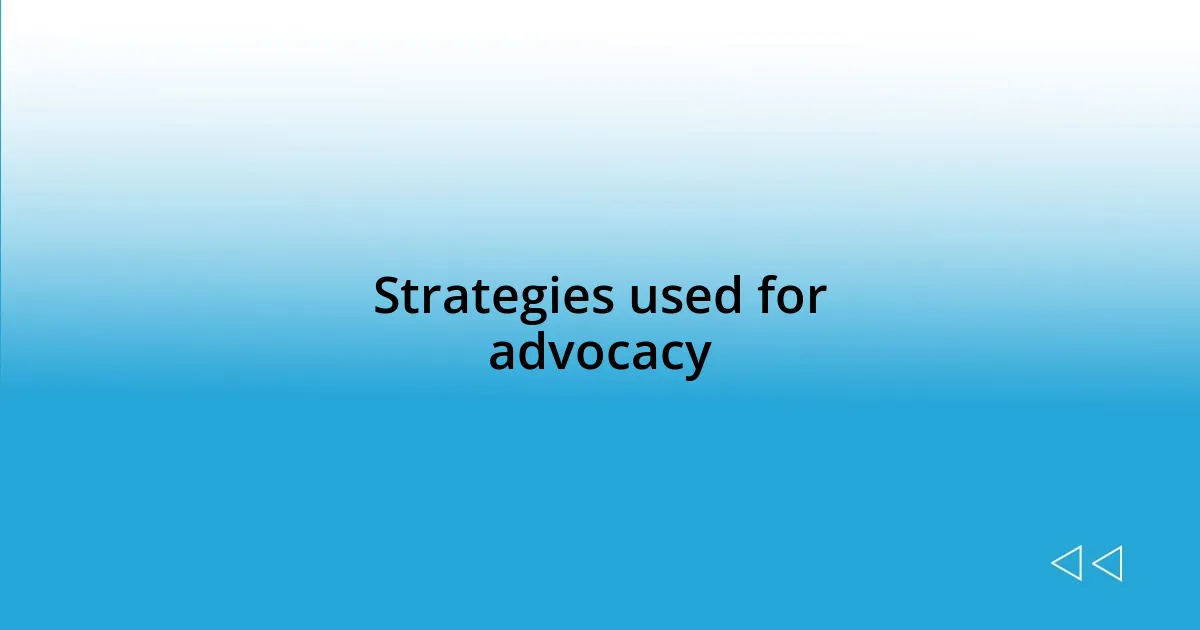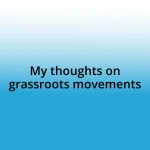Key takeaways:
- The suffrage movement transformed women’s roles in society and laid the groundwork for future civil rights struggles, inspiring ongoing advocacy for marginalized voices.
- Key strategies of the suffrage movement included public demonstrations, coalition building, and educational campaigns, which remain effective in today’s advocacy efforts.
- The emphasis on resilience and persistence reminds us that every small victory contributes to larger goals, underscoring the importance of community support in advocacy.
- Intersectionality is crucial in modern movements, as recognizing diverse identities leads to a more inclusive and effective fight for justice.

Understanding the suffrage movement’s impact
The suffrage movement had a profound impact not just on the right to vote, but also on women’s roles in society. I often wonder how different our world might look today if not for the courageous women who rallied together, risking their safety and sanity for what they believed in. Imagine the strength it took for those early activists to stand outside in the face of hostility, wielding not weapons but words; it’s both inspiring and humbling.
As I reflect on the movement, I can’t help but think about the shift it created in societal norms. Once marginalized, women began to claim their space—not just at the ballot box but in every corner of public life. It stirs a sense of responsibility within me; if these brave women could fight for their voices, how can I advocate for those who still face barriers today?
Ultimately, the suffrage movement laid the groundwork for future civil rights struggles, igniting a flame that would burn through generations. Have you ever thought about how interconnected these movements are? Each step towards equality challenges us to continue the fight, emphasizing that progress is often built on the shattered chains of those who came before us.

Strategies used for advocacy
The suffrage movement utilized a variety of strategic approaches that not only galvanized support but also drew in attention to their cause. I find it particularly fascinating how methods like peaceful protests and carefully crafted petitions demonstrated the power of collective voices. Even today, I see parallels in these tactics; grassroots organizing can be just as impactful when fighting for any cause.
Key strategies included:
- Public demonstrations: Marches and rallies brought visibility to the suffragist cause, making it difficult for society to ignore their demands.
- Shifting rhetoric: Leaders like Susan B. Anthony reframed the discussion around voting rights as a moral obligation, appealing to a sense of justice.
- Coalition building: The movement often aligned itself with other social issues, broadening its base of support.
- Education campaigns: Educating women and the broader public about their rights helped cultivate a strong advocate network.
- Use of media: Pamphlets, newspapers, and even the early use of social media fostered a greater awareness and rallied support across diverse demographics.
I remember feeling a sense of empowerment when I engaged in organizing efforts in my community. It mirrored these historical strategies, making me realize that combining voices can create ripples of change, just as it did for those trailblazing women.

Lessons in resilience and persistence
The suffrage movement reveals remarkable lessons in resilience and persistence. I often think about the unwavering determination exhibited by those early activists. They faced relentless opposition—yet they pressed on, believing deeply in their right to be heard. This dedication inspires me to confront challenges in my own pursuits, prompting me to ask: How can I harness my persistence in the face of obstacles? It’s about developing a mindset that refuses to give in, much like the suffragists who turned setbacks into stepping stones toward their ultimate goal.
Another striking example of resilience was the relentless campaigning and advocacy over decades. I remember a time when I organized a small event to raise awareness for a local issue, and it felt daunting at first. Yet as I built enthusiasm and rallied others, I found that every small victory propelled us forward. The suffragists similarly celebrated milestones, using each moment of progress as motivation to push harder. Their story teaches me that persistence is essential; even the smallest actions matter in the grander scheme of change.
Lastly, the sense of community among women during the suffrage movement reflects how collective strength can amplify individual perseverance. When I collaborated with friends on a project to support a local charity, I cherished the encouragement we offered each other. Just as those suffragists leaned on one another for support, I learned that resilience is often nurtured within a community. Together, we can forge a powerful path, one that honors the spirit of those who fought for a cause bigger than themselves.
| Lessons Learned | Personal Insights |
|---|---|
| Resilience in Adversity | Embracing challenges inspires personal growth. |
| Celebrating Small Victories | Small successes act as motivation for greater achievements. |
| Community Support | Collective strength enhances personal perseverance. |

The role of intersectionality
The suffrage movement’s approach to intersectionality revealed just how crucial it is to consider multiple identities in social justice efforts. Activists like Ida B. Wells highlighted the unique struggles faced by Black women, showing that the fight for women’s rights couldn’t be separated from the fight against racism. I often ponder how our own movements today can similarly uplift diverse voices; aren’t we all better off when we embrace the full spectrum of experiences?
Embracing intersectionality meant that suffragists had to navigate various social issues and form alliances with other marginalized groups. This collaboration created a more inclusive movement but also opened up conversations about class, race, and gender that were often uncomfortable. Reflecting on my experiences, I recall a time when I volunteered for a campaign that focused on environmental justice, recognizing that low-income communities faced the brunt of climate change. It struck me that while my passion for the environment was strong, I needed to listen and learn from those whose lives were directly impacted.
In recognizing the role of intersectionality, we can acknowledge the complexity of individual experiences and the interwoven nature of different struggles. This realization invites me to ask: how can my actions today contribute to a more holistic understanding of advocacy? In my journeys, I’ve found that addressing just one facet of a person’s identity fails to capture their full story—and only by elevating those stories can we create a movement that is truly reflective of our collective fight for justice.

Modern applications of suffrage lessons
Modern applications of suffrage lessons can be seen vividly today in how we advocate for rights and inclusivity. I often wonder about the impact of grassroots movements in my community; they remind me of the suffragists’ approach to mobilizing support. For instance, when I helped organize a town hall meeting to address housing inequities, I felt firsthand how community engagement echoes that spirit. Just like those early advocates, we harness our voices to push for change, underlining that collective action remains vital for modern-day struggles.
Delving deeper into the lessons of persistence, I reflect on a recent initiative I joined that aimed to bridge the gender pay gap. The campaign faced numerous hurdles, from pushback by skeptical businesses to a lack of initial funding. Yet, similar to the suffragists who faced fierce opposition, our team never wavered. I still recall the excitement after securing our first sponsor; it reignited our commitment and fueled our momentum. Isn’t it fascinating how celebrating small wins can elevate our morale just as it did for those early activists?
Lastly, the emphasis on intersectionality from the suffrage movement teaches us that advocacy must always be inclusive. I remember attending a local rally that brought together various marginalized voices to address systemic inequalities. The shared experiences and stories really moved me—it was a powerful reminder of how, like the suffragists, we can only move forward by acknowledging and uplifting all voices. Each story enriches our understanding, making our collective battle for justice much stronger. How can we ensure that every identity is represented in our advocacy today? Embracing diversity in our efforts not only honors the legacy of the suffragists but also creates a more effective and unified front for change.

Continuing the fight for equality
The fight for equality never truly ends; it merely evolves. I often reflect on how the passion I felt volunteering for a local LGBTQ+ rights group mirrors the dedication of those suffragists. One time, during a Pride event, I was moved by individuals sharing their stories of struggle and resilience. Isn’t it fascinating how these personal narratives not only uplift the community but also challenge societal norms, just like suffragists did in their time?
As I work alongside activists today, I’ve noticed that the fight for equality requires constant adaptation to new challenges. A few months ago, I participated in a campaign addressing racial equity in education. The discussions were sometimes heated, but I realized that discomfort is often necessary for growth. Why do we hesitate to engage in conversations that make us uneasy? For me, it’s a reminder that true progress is rarely comfortable, yet it is crucial for understanding different perspectives.
Equally important is the need to bring younger generations into this fight. I remember mentoring a group of high school students passionate about climate justice. Their fresh perspectives had me questioning my own approach to advocacy—are we really preparing them to carry the torch? By connecting with young activists, we can foster a movement that not only honors those who came before us but is also equipped to tackle the fresh challenges of today. It’s empowering to see the torch being passed, don’t you think?
















